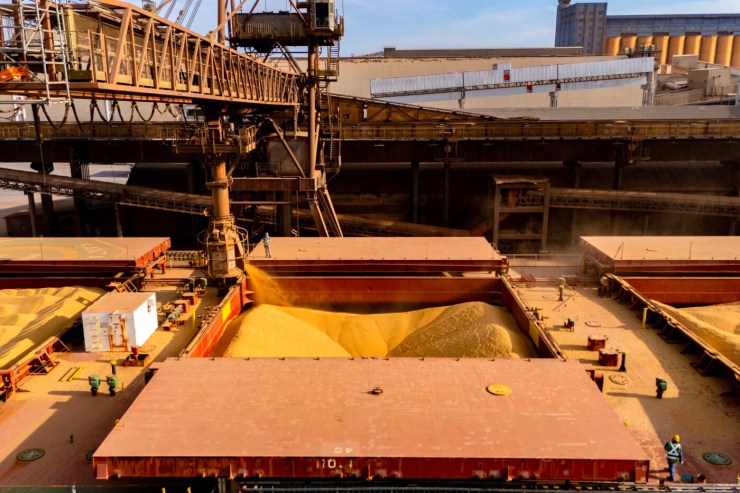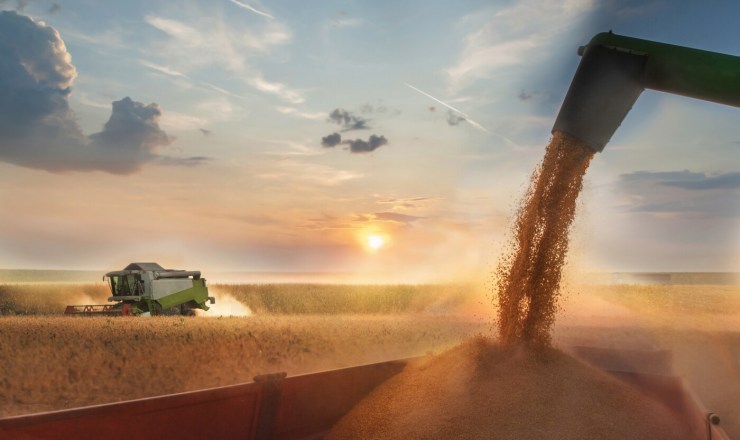The soybean harvest in Rio Grande do Sul is progressing significantly, reaching 80% of the areas sown in the 2024/2025 harvest, with 17% of the crops maturing and 3% in grain filling. According to the Informativo Conjuntural, released last Thursday (24) by Emater/RS-Ascar, the harvest is favored by stable weather conditions, with a predominance of sunny days and dry weather, which also contributed to logistics operations.

Photo: Jaelson Lucas
The sequence of dry days reduced the content of harvested soybean grains, which varied between 12% and 13%, eliminating the need for drying at storage points and, thus, accelerating the flow, which was delayed by the April rains. The low moisture content of the grains also makes it possible to reserve seeds suitable for the next harvest, which have satisfactory quality potential, given the health of the crops and natural drying in the field.
In the administrative region of Emater/RS-Ascar in Bagé, on the Western Border, dry weather led to an intensification of the harvest. In Uruguaiana, where irrigated crops predominate, mainly in the furrow-ridge system, yields range from 1,200 to over 3,000 kg/ha, reflecting irrigation failures, either due to prioritization of supply to rice crops or due to technical deficiencies associated with high temperatures during the reproductive period. In Campanha, in Hulha Negra, approximately 40% of crops were harvested and yields range from 600 kg/ha (in areas assessed by Proagro) to over 3,000 kg/ha. Fungicides were applied to crops planted at the end of January. Desiccation has been necessary mainly in replanted areas or areas with low populations, where weeds were present.
Corn
Compared to other summer crops, corn harvesting continues to be carried out more slowly and in a staggered manner, reaching 89% of crops, mainly in the Northeast of the State. In the small-scale regions, the operation has evolved little, conditioned on the use of the cereal for internal consumption on the properties.

Photo: Freepik
Late crops (4% in grain filling and another 7% in maturation) have good production potential, favored by the occurrence of rain in critical stages of development and by mild temperatures, which have allowed greater accumulation of photoassimilates.
At the same time, producers are organizing themselves for the 2025/2026 harvest, sowing cover crops, especially forage radish, aiming at subsequent desiccation. When purchasing seeds, there is preference for early cultivars and those with tolerance to the corn leafhopper (Dalbulus maidis), a strategy aligned with more favorable market conditions and preventive phytosanitary management.
Corn Silage
The corn silage harvest has advanced significantly, benefiting from dry weather, which optimized the operation and adjusted the moisture content of the green matter destined for ensilage to ideal levels (between 30% and 35%). This index is essential for homogeneous fermentation and nutritional preservation. In addition, accelerated drying reduced the risk of unwanted microbial activity and losses due to secondary fermentation, reinforcing the quality of the silo. It is estimated that 88% of the area has been harvested, 4% are in the early stages of physiological maturation, and 8% are in grain filling.
Rice

Photo: Leandro Fidelis
The rice harvest has progressed and reached 87%, favored by dry weather throughout the period. In some locations, operational difficulties were recorded due to dense fog and cloudy days. However, as of last Thursday (04/17), weather conditions improved significantly and the harvest continued, with minimal incidence of mechanical damage, due to the reduction in grain moisture content to levels below 18%. However, the large thermal amplitude observed during the period, with daytime temperatures above 30°C and minimum temperatures below 10°C, has intensified the susceptibility of the grains to breakage during harvesting and processing, impacting commercial classification.
Bean
The 1st bean harvest in the State has been completed and the estimated productivity is 1,838 kg/ha in an area of 49,901 hectares. The harvest of the 2nd bean harvest reached 20% of crops, benefiting from the weather conditions. There are 22% of bean crops in maturation, 38% in grain filling, 12% in flowering, and 8% in vegetative development. The productivity obtained is close to 1,300 kg/ha.
Fruit
Citrus – In the administrative region of Emater/RS-Ascar in Santa Rosa, citrus trees are in the fruiting phase. Okitsu bergamot, navel orange, Céu orange and Salustiana are being harvested, with possible sales at R$ 3.00/kg. Aphids, mites, leafminers and stink bugs continue to attack. The lack of rain during development has caused physiological disorders, such as cracking and fruit drop, especially in navel oranges.

Photo: Marcos Tang
In the Bagé region of São Gabriel, the harvest of the Okitsu bergamot orchards continues, with good productivity, being sold on the property for R$ 1.99 to R$ 2.10/kg and in the markets for R$ 5.99/kg. The harvest of the Ponkan bergamot begins in the last week of April. In the orange orchards, the harvest of the juice variety continues, which is sold on the property for R$ 3.50/kg. The harvest of the Navelina variety begins, and prices reach R$ 9.00/kg.
Pecan nuts – In the administrative region of Emater/RS-Ascar in Santa Maria, in Cachoeira do Sul, the main producer of pecan nuts in Latin America, the harvest has begun, reaching 5%. Initial averages indicate productivity of over two t/ha in areas with irrigation.
In the Erechim region, the pecan crop is in the harvest phase on 140 hectares, and the fruit is of adequate quality. However, productivity is below expectations. The price is R$20.00/kg in shell. In Soledade, the crop is in the final stage of formation/maturation, and a harvest of 30% is expected to be smaller than normal. The price has not yet been fully defined, but should be around R$15.00/kg for industry, varying according to the quality of the nuts and the yield.
Pastures and Livestock
Oat pastures are well established. Summer species are in decline and are gradually replaced. Perennial pastures and native grasslands still provide forage. Due to reduced rainfall, conservation practices such as haymaking and pre-drying are intensified, and the demand for winter forage seeds is increasing.
Dairy farming

Photo: Lucas Fermin
Considering the final phase of cultivated pastures, characterized by higher dry matter content and lower protein concentration, the animals maintain satisfactory body condition scores due to supplementation with concentrated feed. Monitoring and health control practices are carried out, with emphasis on tick management.
In the administrative region of Emater/RS-Ascar in Passo Fundo, the incidence of ticks and botfly persists, requiring control at strategic points, even with the decrease in temperatures, especially at night. Symptomatic anthrax was recorded on one property. In Pelotas, milk production is in transition between the end of summer pastures and the implementation of winter pastures, such as oats and ryegrass. There is concern regarding the high infestation of ectoparasites, such as flies and ticks, and preventive treatments are indicated to avoid diseases, such as parasitic tristeza. In Porto Alegre, inputs are purchased for the implementation of winter pastures and for sanitary management aimed especially at controlling ticks.




